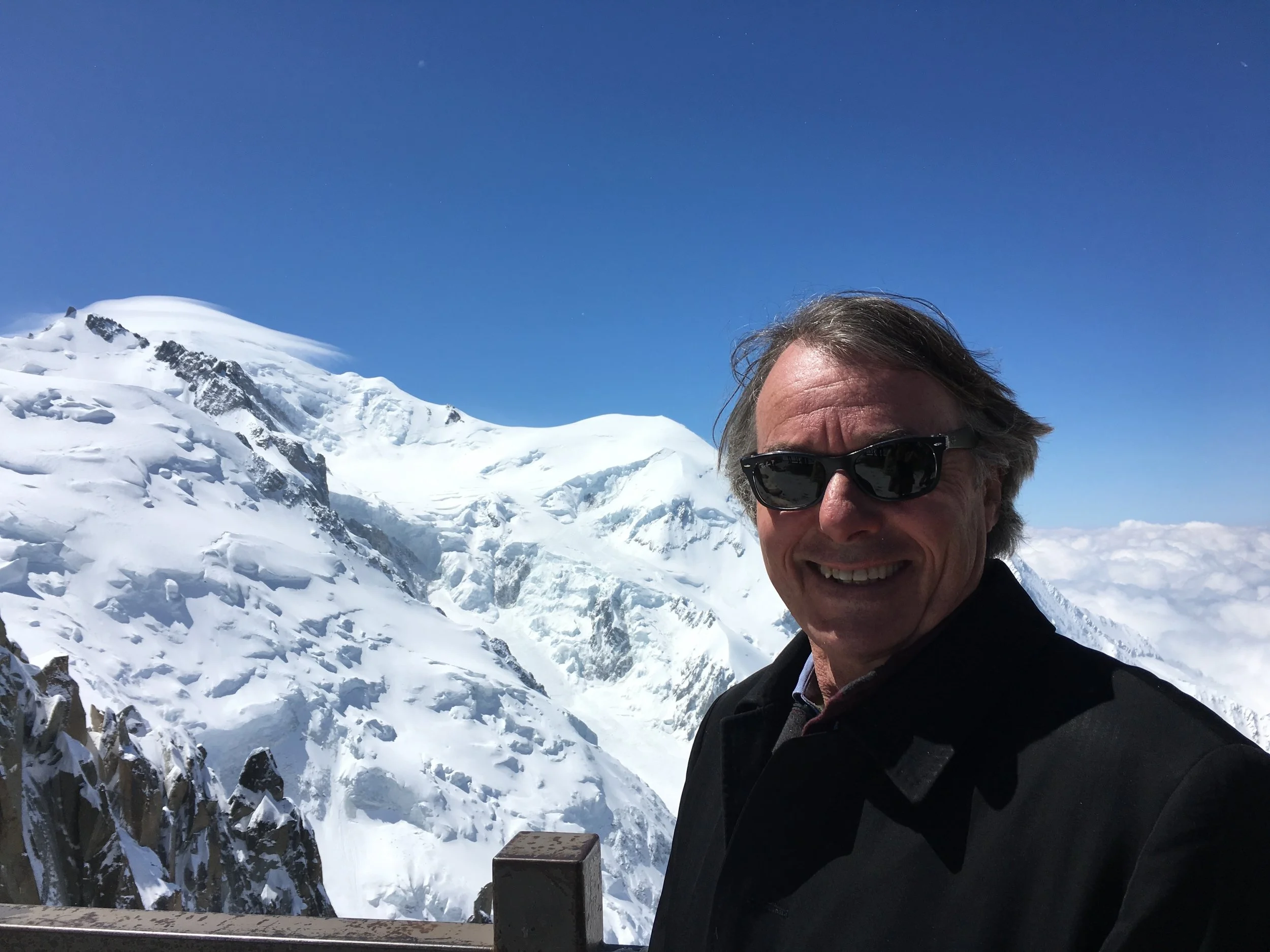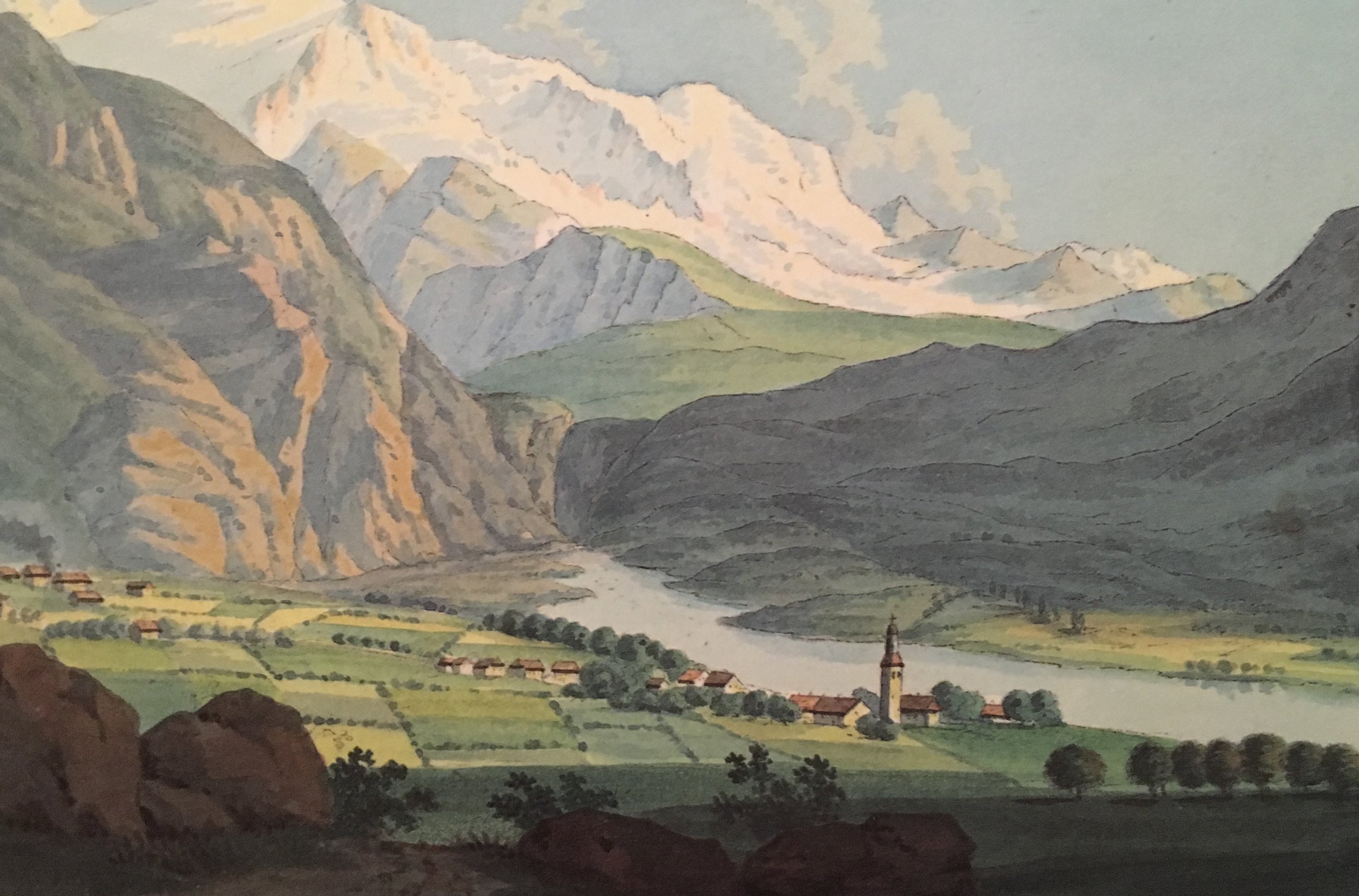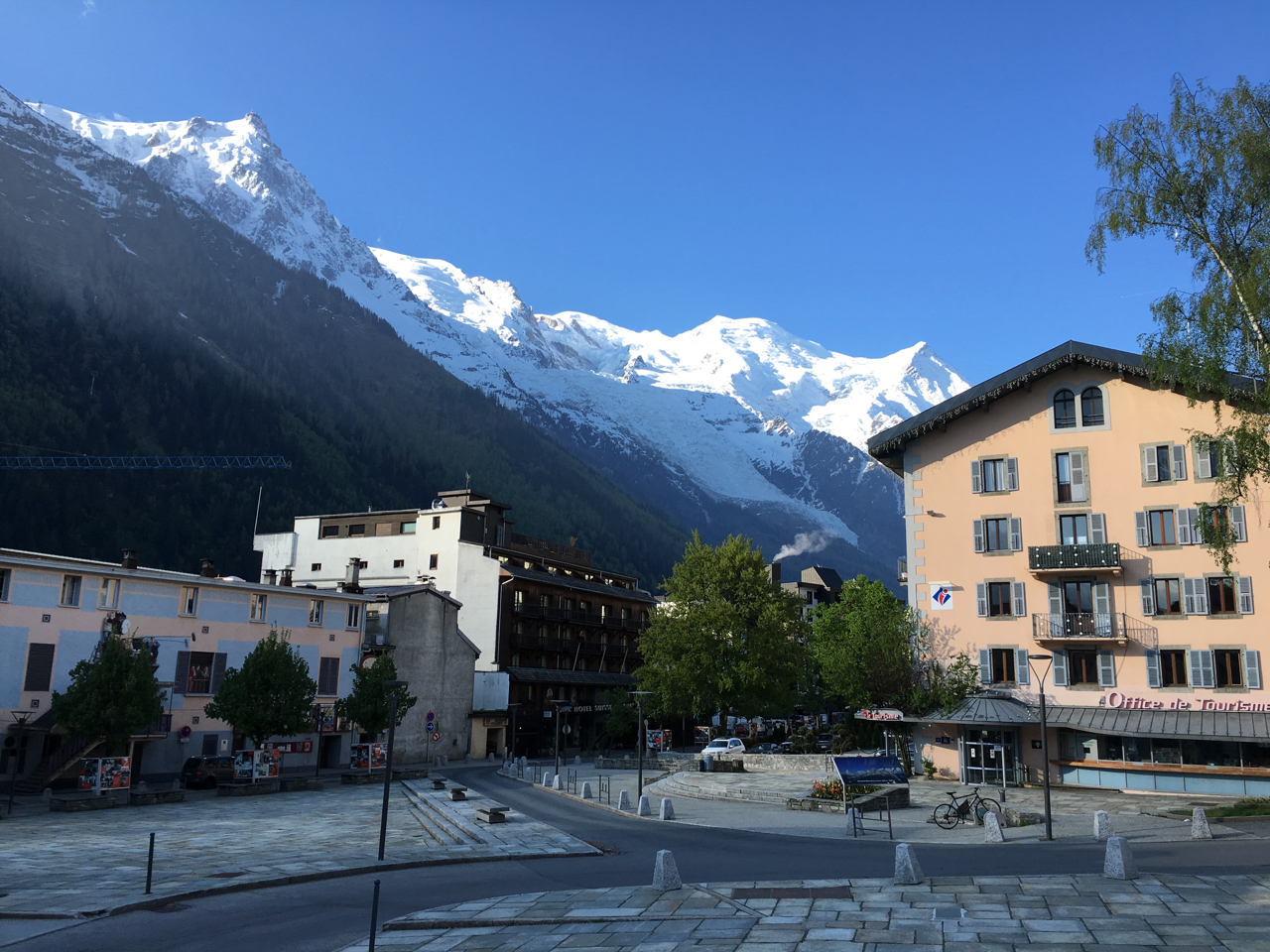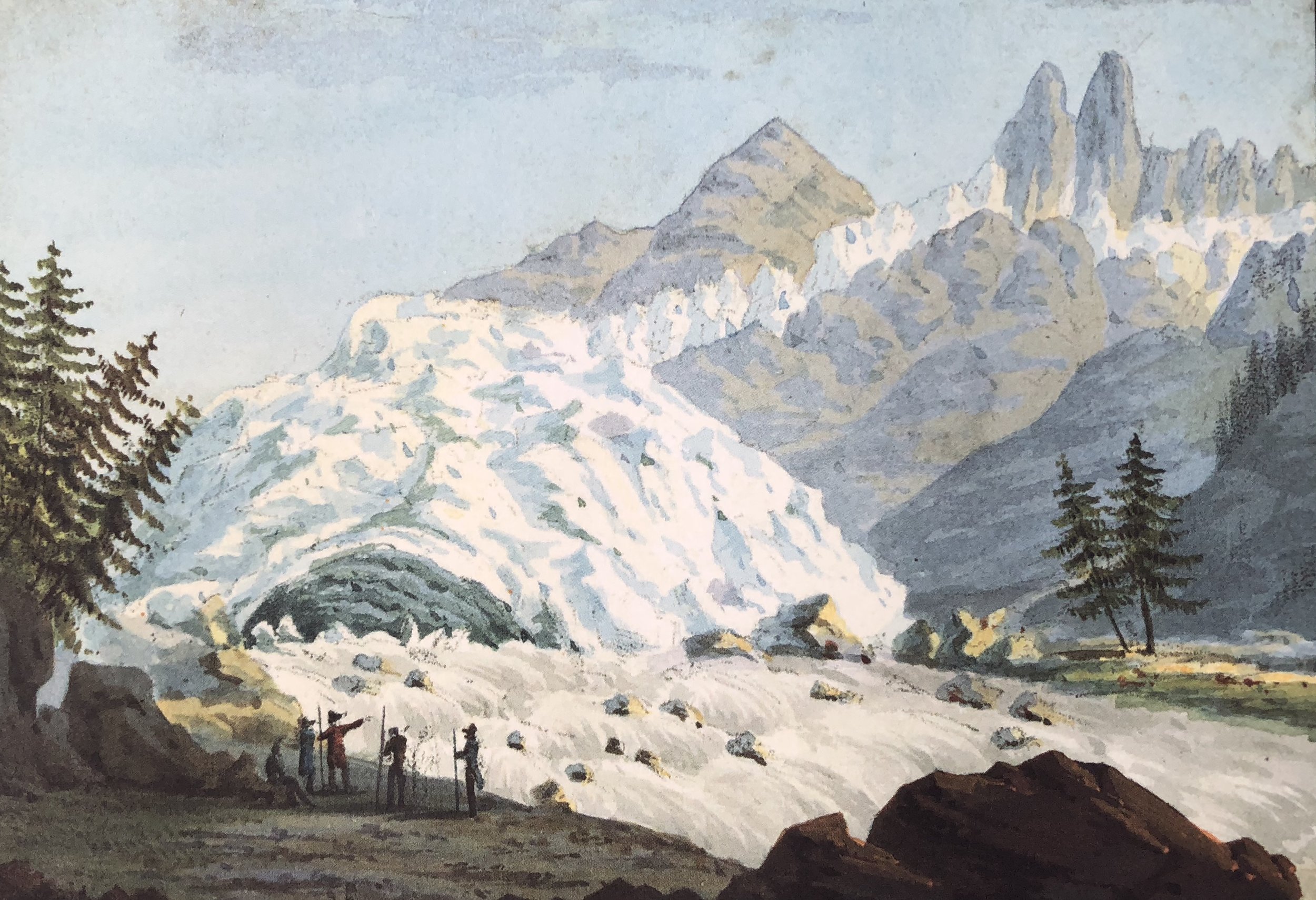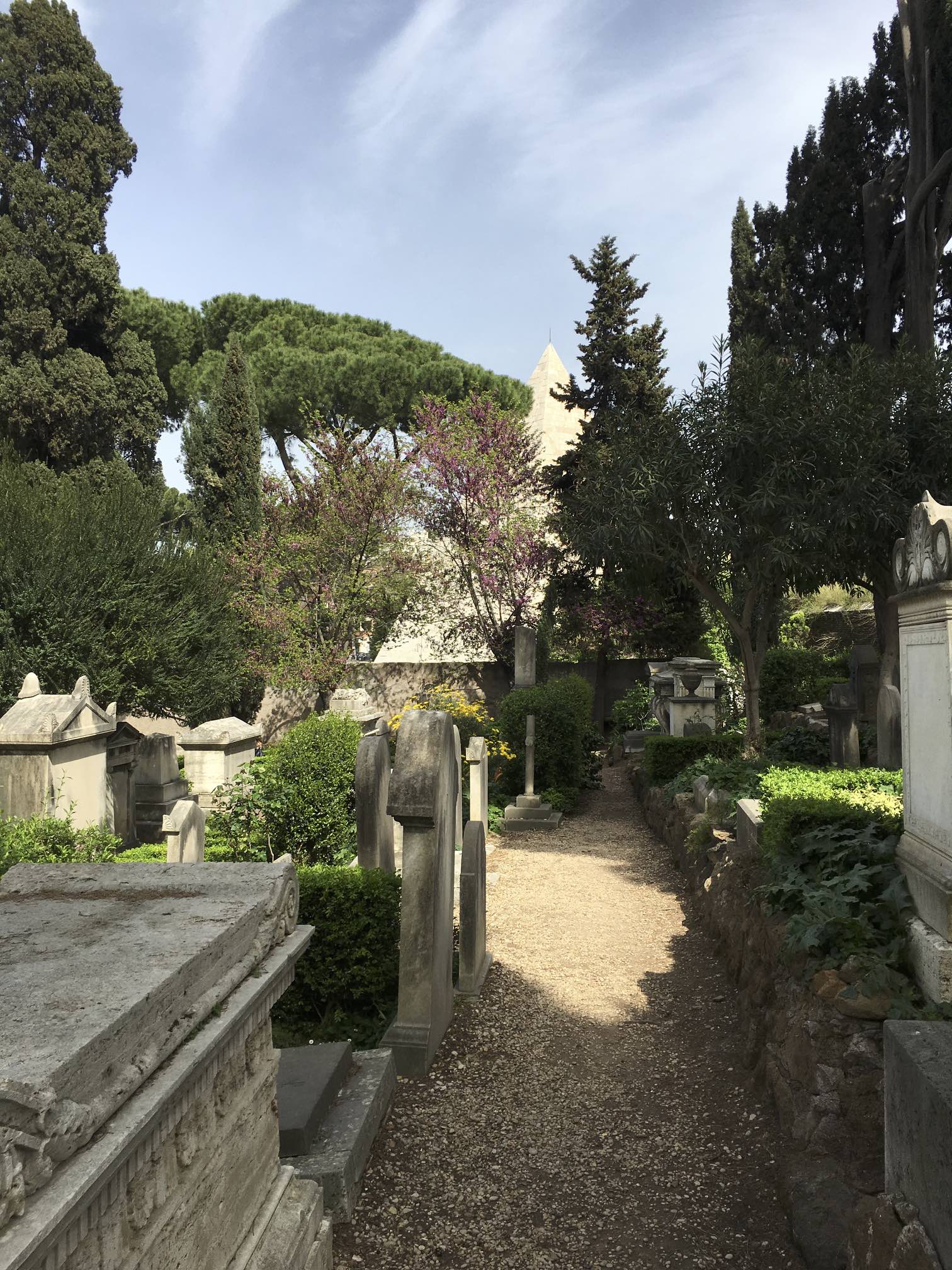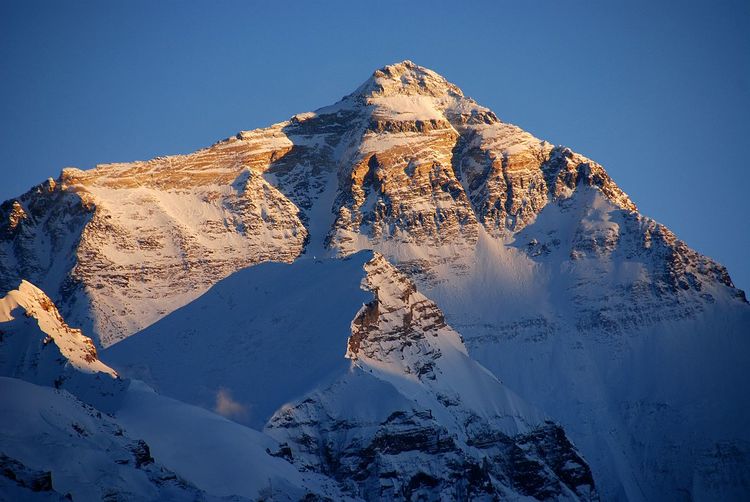
Images and stories from around the world
AUDIO VISUAL PRESENTATIONS
A City of Death: The Shelleys and Mont Blanc
In September of 2017 "The Shelley Conference" took place in London, England. It brought together some of the greatest Shelleyans alive, and it introduced to the world a new generation of young scholars brimming with interesting ideas about Mary and Percy. Carl McKeating is one of those young scholars. Carl introduces some startling insights into what and who shaped the impressions the Shelley's formed of Mont Blanc and its environs. Those impressions were to influence some of the most important literature in the western canon: Percy's poem, Mont Blanc and Mary's novel, Frankenstein. Please join Carl for a thrilling, insightful 20 minute excursion to Chamonix in 1816!
Graham with Mont Blanc in the background, 2016.
One of the genuine highlights of the Shelley Conference 2017 was a dynamic presentation by University of Leeds scholar Carl McKeating: "A City of Death: The Shelleys and Mont Blanc." Taking Mary and Percy’s History of a Six Weeks Tour as his focus, McKeating explores what was for me an exciting but hitherto poorly understood aspect of the book: the extent to which Mary’s and Percy’s perceptions of Mont Blanc were influenced and even conditioned by the tour guides they employed.
Carl McKeating.
When I met Carl at the Shelley Conference 2017, I was delighted to discover that we shared a love of the mountains and rock climbing. He has even authored books and articles on the subject. You can learn more about him here. Of his experiences, Carl writes,
I feel my research benefits from the insight offered by a climbing and mountaineering background. I have had a varied career that for the most part has prioritised spending time in mountain ranges. Nonetheless, I momentarily settled down to teach and left my most recent post as a secondary English teacher to commence the PhD at Leeds. I studied at Lancaster University for my undergraduate degree, where the tutorship of the poet Paul Farley was an inspiration for future academic and creative writing.
But before getting to McKeating's great talk (included in audio-visual below), I wanted set the scene a little and share some of my own experiences with a mountain that in some ways can feel a bit anti-climactic after having read all the great literature about it. So, buckle up: we're headed to the Alps!
Mont Blanc seen from Geneva. Copyright Graham Henderson, 2016.
The photograph above provides a view of the Mont Blanc Massif that is identical to that which the Shelleys might have enjoyed from their window in the Hotel d'Angleterre. I say might because the summer the Shelleys spent in Switzerland came to be known as the "Year Without Summer." Cold, dark, rainy - even snowy - the summer of 1816 was exceptionally bad. The unseasonable weather was attributable to a combination of factors. Europe was still in the grips of what today we call the "little ice age". But the conditions were exacerbated by the eruption in 1815 of a massive volcano, Mount Tambora. You can read about it here. It is more likely that the Shelley's saw something like this (perhaps minus the dramatic rainbow!):
View of Mont Blanc Massif, obscured by clouds. Copyright Graham Henderson, 2016.
If you travel to Mont Blanc today, you will have a very different experience from that of the Shelleys, who described the famous Swiss mountain as sublime and infused with supernatural terrors. Today, you can leave Geneva on a modern superhighway and be in your hotel room in just over an hour. Mary and Percy's journey required almost three days on horseback.
If you wanted to avoid the superhighways and follow the footsteps of the Shelleys instead, you follow the old “Imperial Highway” which takes you through Servox (not shown on the map above). The first part of the journey is through wide open, picturesque countryside with no hint of sublimity. Here is what it would have looked like to the Shelleys when they reached the environs of Bonneville just south of Geneva:
Gabriel Charton, "Saint-Martin". From Souvenirs Pittoresques des Glaciers de Chamouny, 1821; reprinted by Tony Astil, 2015
However, the further you go, the more intimations there are of what is to come. For example, I stopped near Oex and walked to the base of the Cascade de l'Arpenaz. Percy Shelley wrote about this place in his letter to Thomas Love Peacock on 22 July 1816. You should carefuly compare it with the image to the right to see how startling accurate Percy's description is:
Cascade de l'Arpenaz. Copyright Henderson
"They were no more than mountain rivulets, but the height from which they fell, at least of twelve hundred feet, made them assume a character inconsistent with the smallness of their stream. The first [i.e. the Arpenaz waterfall] fell from the overhanging brow of a black precipice on an enormous rock, precisely resembling some colossal Egyptian deity. It struck the head of the visionary image, and gracefully dividing there, fell from it in folds of foam more like to cloud than water, imitating a veil of the most exquisite woof. It then united, concealing the lower part of the statue, and hiding itself in a winding of its channel, burst into a deeper fall, and crossed our route in its path towards the Arve."
From there I continued on the Imperial Highway to Servoz. The road climbs up on the shoulder of the valley north of the ravine, reaching a considerable height at Servoz which today is a gorgeous little village where properties are on sale for almost USD $2,000,000. When Shelley visited, it was little more than a hamlet. After Servoz, the road then descends to the valley floor and the valley narrows dramatically. It would have looked like this to Shelley. You can see the ravine of the Arve in the middle distance:
Gabriel Charton, "Servox". From Souvenirs Pittoresques des Glaciers de Chamouny, 1821; reprinted by Tony Astil, 2015. The church is still there.
Shortly after you enter this gorge, the river suddenly (and famously) makes a sharp turn to the left which dramatically reveals the Mont Blanc Massif in all of its majesty. Here is what Shelley wrote:
"As we proceeded, our route still lay through the valley, or rather, as it had now become, the vast ravine, which is at once the couch and the creation of the terrible Arve. We ascended, winding between mountains whose immensity staggers the imagination. We crossed the path of a torrent, which three days since had descended from the thawing snow, and torn the road away... From Servoz three leagues remain to Chamouni.—Mont Blanc was before us—the Alps, with their innumerable glaciers on high all around, closing in the complicated windings of the single vale—forests inexpressibly beautiful, but majestic in their beauty—intermingled beech and pine, and oak, overshadowed our road, or receded, whilst lawns of such verdure as I have never seen before occupied these openings, and gradually became darker in their recesses. Mont Blanc was before us, but it was covered with cloud; its base, furrowed with dreadful gaps, was seen above. Pinnacles of snow intolerably bright, part of the chain connected with Mont Blanc, shone through the clouds at intervals on high. I never knew—I never imagined what mountains were before. The immensity of these aerial summits excited, when they suddenly burst upon the sight, a sentiment of extatic wonder, not unallied to madness. And remember this was all one scene, it all pressed home to our regard and our imagination. Though it embraced a vast extent of space, the snowy pyramids which shot into the bright blue sky seemed to overhang our path; the ravine, clothed with gigantic pines, and black with its depth below, so deep that the very roaring of the untameable Arve, which rolled through it, could not be heard above—all was as much our own, as if we had been the creators of such impressions in the minds of others as now occupied our own. Nature was the poet, whose harmony held our spirits more breathless than that of the divinest."
When I arrived in the valley, I encountered the same problem that bedeviled the Shelleys -- Mont Blanc was shrouded with clouds.
The Vale of Chamonix, 2016. Copyright Henderson.
One thing that the modern traveler misses is the thundering of the Arve. The modern roads are far removed from the river and the roar of traffic obscures that of the river itself. One other thing I can tell you is this – pictures do the valley absolutely no justice whatsoever. No picture I have ever seen conveys the manner in which the mountains seem to, as Shelley notes, “overhang” the valley floor. Here is a contemporary painting which offers a view the Shelleys would not have seen because they did not travel to the Col de Voza:
Gabriel Charton, "Le Col de Voza." From Souvenirs Pittoresques des Glaciers de Chamouny, 1821; reprinted by Tony Astil, 2015
Mont Blanc is not even in the picture; it is off to the right. In the foreground, you can see the Glacier des Bossons. Just beyond it lies the spire of the church in Chamonix and then the terminus of the Mer de Glace, which you can see actually encroaches on the valley floor itself. Today these glaciers have long since receded into the mountains.
It is a point worth making that for travelers in the early 19th century, even for those such as the Shelleys who had never seen the Alps, there is an aura of the picturesque that infuses the valley – not the sublime. In other words, the landscape around Mont Blanc is ruggedly beautiful, rather than overwhelmingly powerful, a quality we do find in Shelley's great poem "Mont Blanc." While they were in the valley, the Shelleys had difficulty actually seeing Mont Blanc – and this is not at all unusual. A cloud deck seems to perpetually overhang the valley. But even when you can see it, the mountain is not exactly imposing in-and-of-itself. Here is a photo I took a couple of years back that will give you a better idea of this:
Mont Blanc Massif from Chamonix. Copyright Henderson, 2016.
Mont Blanc is not the sharp peak the left. Nor is it the one on the right. In fact, it is the subtle summit set back from the rest almost dead center of the photograph. Trust me, it does not in-and-of-itself inspire the feelings of awe and dread we encounter in Shelley's poem bearing the mountain's name. It is not at all evident that it is even the tallest mountain. In fact, the reverse seems to be true. The Aguile de Midi looms precipitously above your head in Chamonix – Mont Blanc is a distant and altogether benign presence. Not like Mount Everest, for example. I have stood at North Face Base Camp – and let me tell you, up close Mount Everest looks like a stone-cold killer:
North Face of Mount Everest from Rongbuk. Copyright Henderson, 1994.
There is no doubt that the Shelleys’ minds would have been very much more impressionable than ours are today – and less inured to wild landscapes. They had never actually seen real mountains. Very few travel guides existed that could prepare you for what you were about to see. As I mentioned before, in the 1810s, the Mont Blanc glaciers actually spilled out onto the valley and were menacingly advancing (for an idea of how this might have looked to the Shelleys, see the image below). The Shelleys were also fresh from their stay at the Villa Diodati where they had engaged in a ghost-story competition! Then there was the outlandish weather that was the hallmark of the “Year Without Summer”. All of this may well have perhaps primed then for, shall we say, a heightened experience.
Gabriel Charton, "La Source de l'Arvenon". From Souvenirs Pittoresques des Glaciers de Chamouny, 1821; reprinted by Tony Astil, 2015.
The glacier can not even be seen from Montanvert. It is around the corner having retreated 10 miles thanks to climate change- why am I smiling!? Copyright Henderson, 2016.
This leaves us with an obvious dilemma: if the mountain is somewhat unremarkable, why do the Shelleys write about it as if it were the most imposing, threatening presence in the Alps? This is where Carl McKeating picks up the story, for as he tells us, there was another factor which led to the Shelley’s highly emotional response to what they saw: they were powerfully influenced by their tour guides. As McKeating points out, critics have rarely viewed the Shelleys as tourists, but this is exactly what they were. In fact, in several instances, Percy bluntly complains about the presence of other tourists – demonstrating that the more things change, the more they stay the same!
Both Mary and Percy frame Mont Blanc as a place where supernatural forces lurked and where death was imminent. References to Mont Blanc as the abode of witches appears in Byron’s Manfred, Mary’s Frankenstein and Percy’s "Mont Blanc." Percy at one point records witnessing an avalanche -- in July 1816. McKeating speculates on the role the guides might have played at such a moment. While their duty was to keep the guests safe, they also wanted to take tourists to the most exciting places – places which also might involve an experience of danger.
The guides also regaled their charges with folklore and wild tales. McKeating suggests that much of what we read in the accounts of Mary and Percy is derived directly from stories they were told. Mary often begins an episode with the words, “our guide told us a story….”
McKeating also notes how Percy’s impression of Mont Blanc radically evolved over an extremely short period of time. Before he left, Percy had written to Byron referring to the mountains as “palaces of nature.” By the time he wrote about them in his great poem, they had become “palaces of death.”
McKeating is also one of the most entertaining presenters I have ever seen inside or outside of the academy. You will thank me if you take my advice and spend 20 minutes with him while he spins his own tale of mystery, intrigue, witches......and the palace of death!!!
You can visit Carl's profile here. And this is an overview of the research Carl is undertaking at the University of Leeds:
Mont Blanc was a towering presence in the imaginative geography of British eighteenth and early nineteenth century writing, featuring in poetry, fiction, travel literature, and natural philosophy. My work uses a broadly chronological and geocritical approach to investigate the cultural prominence of Western Europe's highest mountain. The period of my study addresses the 'discovery' of Mont Blanc by William Windham's party of 'Eight Englishmen' in 1741, Mont Blanc's first ascent by the Horace Benedict de Saussure-sponsored Paccard and Balmat in 1786, and the mountain's literary blossoming during the Romantic period when it played a key role in the re-evaluation of mountain topography and the formation of identity for British writers including William Wordsworth, Helen Maria Williams, Mary Robinson, Samuel Taylor Coleridge, Mary Shelley, Lord Byron and Percy Bysshe Shelley.
Shelley's Grave - a Glorious Virtual Tour
The Non-Catholic Cemetery in Rome really should be in the top 10 "must visit" attractions for anyone with a literary bent. Virtually everywhere else you go will be overrun with tourists. Not here. What a wonderful place to go and reflect on the life of one of the world's great poets. Take some poetry and a bottle of wine. I took my copy of his Collected Poems and read Epipsychidion. Shelley has a worthy resting place indeed. Build a visit into your itinerary - make the pilgrimage; you will not regret it. It will be a pause that refreshes not just the body, but also the spirit - particularly if you like cats!!!
In the summer of 2016, I was lucky enough to be in Rome on business. For the first time in my life, I made the pilgrimage to the gravesite of my favourite poet.. This is something my father had done in 1950 at the age of 33 - so he beat me by 28 years; I have no excuses. You can read more about his journey here.
I left the Spanish Steps at around noon on an exceedingly hot afternoon. I walked to the Colisseum and then past the Arch of Constantine and down the Via di san Gregorio past the Palatine Hill and onto the Viale Aventino. The road is very busy, but on your right the views can be extraordinarily beautiful. Passing the Circo Massimo, you eventually arrive at your objective. People today call it the "Protestant" Cemetery; but that it not how Italians know it. They call it the "Cemetery for Non-Believers" - or more politely, the "Cemetery for Non-Catholic Foreigners." And this is where Shelley is buried; a foreigner, and, as an atheist, most definitely a "non-catholic." Their website is here (why not donate something!) and you can buy a wonderful new book about the history of the cemetery here. They will celebrate their 300th anniversary this fall.
All photographs, unless specifically noted, were taken by me and I assert my copyright in them. If you want to use them, just drop me a line and credit me.
The Cemetery is surrounded by busy thoroughfares and is an incredibly unexpected oasis of calm amidst the chaos that Rome has become. Very, very few people visit it - which makes it an incredibly desirable place to be in Rome in the 21st Century - Shelley is lucky. When you step through the gates, the world drifts away. Uncannily, noise abates and even the temperature seems to drop. There is a pleasant gift shop where you can buy a very helpful guide book. I recommend that you pause just inside the gates for a leisurely orientation and stock-taking.
The cemetery is crowded with tombstones - clearly a lot of non-catholics found their way to the afterlife in Rome. Here is a view from just inside the gates looking toward Shelley's grave which is at the back immediately in front of the wall.
The circumstances under which Shelley's remains found their way to Rome have been amply chronicled and I would refer you to James Bieri's short account in his biography of Shelley at pages 656 ff. Suffice to say that the individual at the heart of the episode was one of history's least reliable narrators, Edward Trelawney. The bare facts are these. After the cremation, Shelley's ashes were sent to Rome where they awaited burial for some months. They were initially interred in a place which Trelawney deemed unsuitable and in March of 1823 they were moved to their current resting place (Bieri, 657). Trelawney speaks in his memoir, "Record of Shelley, Byron and the Author", of planting eight "of the Italian upright cypresses" (Trelawney, 146). Now if you have a look at the next two images, you can plainly see that the grave is circumscribed by four very tall, very old cypresses. I would love to know if these are the last survivors of Trelawney's cypresses. More on this later. Shelley is buried directly in front of the wall between the two trees in the centre of the photograph:
Here is a short video that gives a better sense of their magnitude:
For the grave of one of the best known and most beloved romantic poets, surprisingly little detail is supplied in the literature about Shelley's beautiful resting place. Richard Holmes provides no image at all. Bieri offers a single poorly composed black and white photograph of the grave stone. Newman Ivey White included a black and white etching which is a copy of William Bell Scott's painting that hangs in the Ashmolean (see below). My father for his part took a handful of pictures. You can see them here in his "Shelleyana" scrapbook. The photograph in the lower right corner is a version of the one you invariably see in books. None of these images come close to conveying the romance and beauty of this place.
My goal is to try to give you some rather different perspectives. I spent an entire afternoon in the cemetery. I deliberately lingered because I wanted to get a sense of the place. I was as interested in the living as the dead. What I observed was that, perhaps unsurprisingly, most people come to visit the graves of the two poets: Shelley and Keats. They tend to pause almost shyly in front of Shelley's grave. Virtually no one lingers and few pictures are taken; the experience seems entirely visual - no one touches anything - no one seems to stop to listen.
So, speaking of unusual perspectives, here is such a thing. Were you to lie on your back on Shelley's grave (which I did not!!!) this is what you would see. I placed my camera on the gravestone (pointing up) and activated the shutter.
It is also possible to walk right around Shelley's grave. This offers some unusual opportunities for different perspectives which have rarely been shared by biographers or visitors. Here, for example, is a panoramic view looking toward the Pyramid of Caius Cestius. You can see Shelley's grave in the lower right corner of the picture.
Here is another view looking toward the pyramid:
The only time I ever saw this view was in the painting by William Bell Scott. Scott is a lesser known pre-Raphaelite who shared his era's fascination which Shelley; he painted this "from nature" in 1873. This is a gorgeous work of art, with a shimmering, preternatural quality that is typical of the pre-Raphaelites. It is virtually never reproduced in books about Shelley. It can also help us to determine whether or not the trees we see today were those planted by Trelawney.
Here it is, feast on it for a moment:
"Shelley's Grave", William Bell Scott, 1873. The Ashmolean Museum, Oxford.
Look at the cypress beside the gravestone in the painting. That is a reasonably mature tree. Had it been planted by Trelawney in 1823, it would have been 50 years old by the time Scott arrived to paint the scene. So that fits. Now, have a look at this next picture. The tree in the middle of the frame is sitting exactly where the cypress is in Scott's painting. Is this proof? No, and I regret I did not think to get a better photograph to make the comparison. Nonetheless, these trees can live for centuries. We probably won't know for sure until one dies and we get a ring count!
To give you a better sense of the place, I took a brief, panoramic video of the cemetery from the foot of Shelley's grave.
And here is the gravestone itself. I went to some lengths photograph it directly from above - a view rarely, if ever, seen in the literature.
The usual photograph looks like this:
It is, perhaps, a matter of taste!. In any event. Here is something you never see. A view of the cemetery taken from behind his grave:
And a panoramic view as well:
I spoke earlier about listening. I took this longer video of the gravestone itself in order to convey a sense of the sounds you hear in the cemetery. While there is a undertone of the traffic noises so typical of modern Rome, you can actually filter it out. It is a very peaceful, magical place.
Shelley, interestingly, is not the only Shelley buried in the cemetery. His son, William, was also buried here, but in the "old" portion of the cemetery. By 1822, fresh burials in this location were forbidden. Mary therefore received permission to have William's remains exhumed so they could be buried along with his father. The painter Joseph Severn was charged with this rather gruesome task. When the stone was lifted, Severn, to his horror, discovered an adult buried there. No further efforts were made to find the boy. However, the gravestone is still there, sadly neglected.
Shelley does not, of course, lie alone in the Protestant Cemetery. When he secured the improved site for Shelley's burial, Trelawney made sure that he secured a spot for himself. There is little to like about Edward Trelawney. He was a narcissistic, parasitical self-aggrandizer who attached himself to Byron and Shelley. Many of the ridiculous myths about Shelley were created by this half-baked adventurer. This is not to say that there is no truth in what he wrote about Shelley; just that it must be read with the greatest caution. Many of his "records" of Shelley were written down 36 years after the fact; such as the "iconic" story of his first meeting with Shelley (Bieri, 601-2). Here is his grave; it is directly beside Shelley's.
Aside from the dates, most of what you see here is a lie. Shelley's and Trelawney's lives were hardly "undivided". Shelley met Trelawney shortly before his death. It is a complete and utter fantasy, promulgated by Trelawney himself, that their "two hearts in life were single hearted". Trelawney, however, had the singular advantage of surviving Shelley and controlling the narrative. He had attached himself to both Byron and Shelley in an effort to gain fame and notoriety - a mission he cynically accomplished. He lived to a great age and published memoirs filled with self-regarding, shifting lies. He is responsible for the creation of a significant portion of the myths that bedeviled Shelley's reputation for generations. It is a pity that he lies forever beside Shelley with lies writ large on his gravestone. There should be some explanatory note or plaque somewhere; but there is none.
However, let's end on a positive note. The cemetery where Shelley and other non-catholics are buried in Rome really should be in the top 10 "must visit" attractions for anyone with a literary bent. Virtually everywhere else you go will be overrun with tourists. Not here. What a wonderful place to go and reflect on the life of one of the world's great poets. Take some poetry and a bottle of wine. I took my copy of his Collected Poems and read Epipsychidion. Shelley has a worthy resting place indeed. Build a visit into your itinerary - make the pilgrimage; you will not regret it. It will be a pause that refreshes not just the body, but also the spirit - particularly if you like cats!!!
All I can tell you is how happy the visit made me!!
There is one postscript worth contemplating. Shortly before Mary died in 1851, Trelawney apparently offered her the plot that he had reserved for himself beside Shelley. She declined.
- A Philosophical View of Reform
- Address on the Death of Princess Charlotte
- Adonais
- Alastor
- Anna Mercer
- Anna Valle
- Byron
- Carl McKeating
- Chamonix
- Ciaran O'Rourke
- Coleridge
- Defense of Poetry
- Earl Wasserman
- Edward Trelawney
- Engels
- Frankenstein
- G. John Samuel
- Gabriel Charton
- Gandhi
- Heidi Thompson
- Hellas
- Hymn Before Sunrise
- James Bieri
- James Connolly
- Jitendra Mishra
- Joseph Severn
- Keats Foundation
- Kelvin Everest
- Larry Henderson
- Manfred
- Mary Shelley
- Mask of Anarchy
- Michael O'Neill
- Michael Scrivener
- Mont Blanc
- Nora Crook
- Ode to the West Wind
- On Christianity
- On Life
- Pandemic
- Paul Foot
- PMS Dawson
- Prometheus Unbound
- Protestant Cemetery
- Queen Mab
- Rabindranath Tagore
- Roland Duerksen
- Rome
- Shelley Conference 2017
- Sir william Drummond
- Skepticism
- Stuart Curran
- Subramania Bharati
- The Cenci
- The Cloud
- The Shelley Conference 2017
- The Sublime
- To Jane With a Guitar
- Tom Mole
- Triumph of Life
- Ulisse Lendaro
- Ursula K Le Guin
- Victorian Literature
- When the Lamp is Shattered
- William Bell Scott



